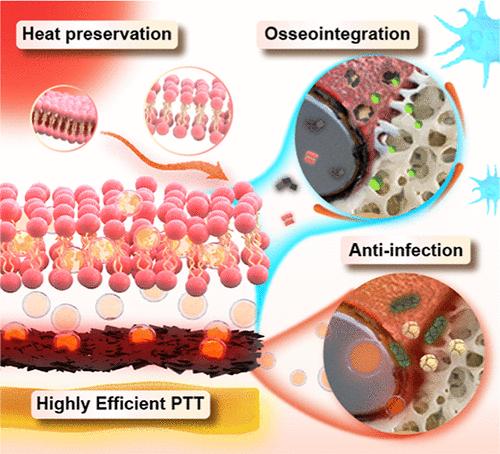当前位置:
X-MOL 学术
›
ACS Appl. Mater. Interfaces
›
论文详情
Our official English website, www.x-mol.net, welcomes your
feedback! (Note: you will need to create a separate account there.)
Engineering Coatings Inspired by Cell Membrane Thermal Dynamics to Enhance Photothermal Therapy and Osteogenesis for Implant Infections
ACS Applied Materials & Interfaces ( IF 8.3 ) Pub Date : 2024-09-25 , DOI: 10.1021/acsami.4c09978 Ailin Hou, Libang He, Mingyue Han, Shijie Shi, Lei Cheng, Jun Luo, Jianshu Li, Jiyao Li, Jiaojiao Yang
ACS Applied Materials & Interfaces ( IF 8.3 ) Pub Date : 2024-09-25 , DOI: 10.1021/acsami.4c09978 Ailin Hou, Libang He, Mingyue Han, Shijie Shi, Lei Cheng, Jun Luo, Jianshu Li, Jiyao Li, Jiaojiao Yang

|
Photothermal therapy (PTT) encounters challenges of rapid thermal loss and potential tissue damage. In response, we propose a Heat-Boost and Lock implant coating strategy inspired by the thermal adaptation of biological membranes, enabling precise local photothermal utilization. This coating incorporates a poly(tannic acid) (pTA) bridging layer on implants, facilitating stable layer-by-layer integration of a black phosphorus (BP) photothermal layer and a top cell membrane Heat-Boost and Lock layer. The cell membrane layer significantly curtails photothermal loss (extending the heat retention by 17.62%) and stores energy within its phospholipid bilayer, boosting photothermal effects near implants (achieving a temperature increasement of 275%). Theoretical analysis indicates that these local heat preservation properties of the cell membrane arise from its low thermal conductivity and phase-change properties. In a Staphylococcus aureus-infected bone implant model, our coating demonstrates precise antibacterial action around implants (reach an antibacterial ratio of 99.52%). The synergetic locking function of cell membrane and pTA delays BP biodegradation, ensuring favorable photothermal stability and long-term osteo-inductive performance (increasing the bone volume fraction by 53.45%). Beyond providing an endogenic biointerface, this strategy extends the application of cell membrane in local thermal management, offering possibilities for effective and safe PTT modalities.
中文翻译:

受细胞膜热动力学启发的工程涂层可增强光热疗法和种植体感染的成骨作用
光热疗法 (PTT) 遇到了快速热损失和潜在组织损伤的挑战。作为回应,我们提出了一种 Heat-Boost and Lock 植入物涂层策略,其灵感来自生物膜的热适应,可实现精确的局部光热利用。该涂层在植入物上加入了聚单宁酸 (pTA) 桥接层,有助于黑磷 (BP) 光热层和顶部细胞膜 Heat-Boost 和 Lock 层的稳定逐层整合。细胞膜层显着减少了光热损失(将保温性延长了 17.62%)并将能量存储在其磷脂双层内,增强了植入物附近的光热效应(实现了 275% 的温度升高)。理论分析表明,细胞膜的这些局部保温特性源于其低导热性和相变特性。在金黄色葡萄球菌感染的骨植入物模型中,我们的涂层在植入物周围表现出精确的抗菌作用(抗菌率达到 99.52%)。细胞膜和 pTA 的协同锁定功能可延缓 BP 生物降解,确保良好的光热稳定性和长期的骨诱导性能(使骨体积分数增加 53.45%)。除了提供内源性生物界面外,该策略还扩展了细胞膜在局部热管理中的应用,为有效和安全的 PTT 模式提供了可能性。
更新日期:2024-09-25
中文翻译:

受细胞膜热动力学启发的工程涂层可增强光热疗法和种植体感染的成骨作用
光热疗法 (PTT) 遇到了快速热损失和潜在组织损伤的挑战。作为回应,我们提出了一种 Heat-Boost and Lock 植入物涂层策略,其灵感来自生物膜的热适应,可实现精确的局部光热利用。该涂层在植入物上加入了聚单宁酸 (pTA) 桥接层,有助于黑磷 (BP) 光热层和顶部细胞膜 Heat-Boost 和 Lock 层的稳定逐层整合。细胞膜层显着减少了光热损失(将保温性延长了 17.62%)并将能量存储在其磷脂双层内,增强了植入物附近的光热效应(实现了 275% 的温度升高)。理论分析表明,细胞膜的这些局部保温特性源于其低导热性和相变特性。在金黄色葡萄球菌感染的骨植入物模型中,我们的涂层在植入物周围表现出精确的抗菌作用(抗菌率达到 99.52%)。细胞膜和 pTA 的协同锁定功能可延缓 BP 生物降解,确保良好的光热稳定性和长期的骨诱导性能(使骨体积分数增加 53.45%)。除了提供内源性生物界面外,该策略还扩展了细胞膜在局部热管理中的应用,为有效和安全的 PTT 模式提供了可能性。













































 京公网安备 11010802027423号
京公网安备 11010802027423号